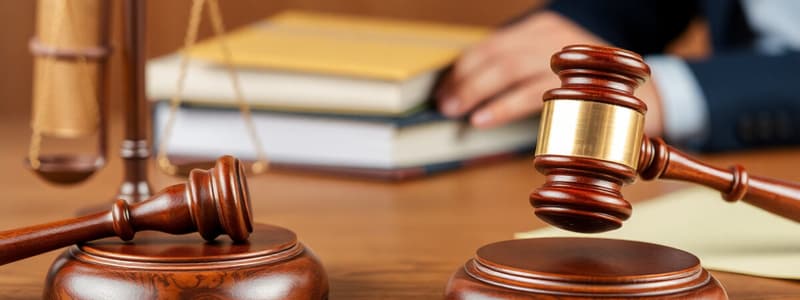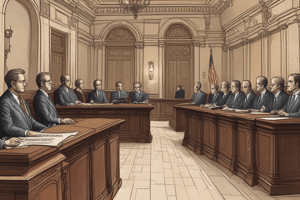Podcast
Questions and Answers
What must the court first assess regarding the admission of evidence?
What must the court first assess regarding the admission of evidence?
- Whether the objection was made after the evidence was presented
- Whether the evidence follows the rules of hearsay
- Whether the evidence was relevant to the case
- Whether the admission affects a substantial right of the party (correct)
What does a party need to do to ensure an objection is preserved?
What does a party need to do to ensure an objection is preserved?
- File a motion after the trial has ended
- Present the objection verbally without specifics
- Notify the jury of the objection
- Include the objection and specific grounds on the record (correct)
What standard should an appeals court apply when viewing a case for retained objections?
What standard should an appeals court apply when viewing a case for retained objections?
- Prejudicial error standard
- Harmless error standard
- Abuse of discretion standard (correct)
- Literal interpretation standard
Under which rule can a defendant claim 'plain error' even if an issue was not preserved?
Under which rule can a defendant claim 'plain error' even if an issue was not preserved?
Which action is suggested for the plaintiff regarding excluded evidence?
Which action is suggested for the plaintiff regarding excluded evidence?
What must be proven for an error to result in a reversal of a trial court's decision?
What must be proven for an error to result in a reversal of a trial court's decision?
Why is simple hearsay not considered a plain error?
Why is simple hearsay not considered a plain error?
What happens if the court admits evidence that violates a rule?
What happens if the court admits evidence that violates a rule?
Who initially decides the admissibility of evidence in a criminal case?
Who initially decides the admissibility of evidence in a criminal case?
What happens if a trial judge concludes that a preliminary fact is not established?
What happens if a trial judge concludes that a preliminary fact is not established?
What does the rule of R104 primarily address?
What does the rule of R104 primarily address?
Under R104, what can parties introduce concerning the weight or credibility of evidence?
Under R104, what can parties introduce concerning the weight or credibility of evidence?
After a judge admits evidence based on a preliminary fact, what opportunity does the jury have?
After a judge admits evidence based on a preliminary fact, what opportunity does the jury have?
If a defendant testifies on a preliminary question, what does this mean for cross-examination?
If a defendant testifies on a preliminary question, what does this mean for cross-examination?
What is the consequence of a judge's decision regarding a preliminary fact?
What is the consequence of a judge's decision regarding a preliminary fact?
What role does R104(a) serve in the context of a judge's ruling?
What role does R104(a) serve in the context of a judge's ruling?
What defines Real Evidence in a legal context?
What defines Real Evidence in a legal context?
What is required for authenticating generic items of evidence?
What is required for authenticating generic items of evidence?
What can a photographer testify regarding the photo taken at a crime scene?
What can a photographer testify regarding the photo taken at a crime scene?
When might unique items still require a chain of custody?
When might unique items still require a chain of custody?
Which of the following is NOT a method for proving chain of custody?
Which of the following is NOT a method for proving chain of custody?
What is a key challenge with digital recordings or photos in terms of evidence?
What is a key challenge with digital recordings or photos in terms of evidence?
Which aspect of a witness's ability to authenticate unique evidence is key?
Which aspect of a witness's ability to authenticate unique evidence is key?
In the context of legal evidence, what does continuous safekeeping refer to?
In the context of legal evidence, what does continuous safekeeping refer to?
What is a primary requirement for evidence to be admitted in court according to FRE 901?
What is a primary requirement for evidence to be admitted in court according to FRE 901?
Which of the following statements about ancient documents is TRUE?
Which of the following statements about ancient documents is TRUE?
What must be shown in the process of authentication to support a finding?
What must be shown in the process of authentication to support a finding?
What can a jury do even after evidence has been authenticated and admitted?
What can a jury do even after evidence has been authenticated and admitted?
Which of the following describes evidence about a process or system?
Which of the following describes evidence about a process or system?
What constitutes an original of a photo according to the guidelines?
What constitutes an original of a photo according to the guidelines?
Which of the following best describes the 'Best Evidence Doctrine'?
Which of the following best describes the 'Best Evidence Doctrine'?
In which situation would FRE 1002 not apply?
In which situation would FRE 1002 not apply?
What is the primary intent of FRE 1002?
What is the primary intent of FRE 1002?
What does FRE 1002 allow regarding documents that are in dispute?
What does FRE 1002 allow regarding documents that are in dispute?
What does the term 'duplicate' imply in the context of FRE 1002?
What does the term 'duplicate' imply in the context of FRE 1002?
Which aspect of FRE 1002 helps prevent unreliable witness testimony?
Which aspect of FRE 1002 helps prevent unreliable witness testimony?
In a bank robbery prosecution, what would qualify under FRE 1002?
In a bank robbery prosecution, what would qualify under FRE 1002?
Under what circumstances can a court judicially notice a fact during a trial?
Under what circumstances can a court judicially notice a fact during a trial?
What is the primary purpose of judicial notice in a legal context?
What is the primary purpose of judicial notice in a legal context?
Which of the following is a valid example of a fact that could be judicially noticed?
Which of the following is a valid example of a fact that could be judicially noticed?
What is the difference between judicially noticing an adjudicative fact and a legislative fact?
What is the difference between judicially noticing an adjudicative fact and a legislative fact?
When can a party request judicial notice of a fact?
When can a party request judicial notice of a fact?
In a criminal case, what is the role of the jury when presented with a judicially noticed fact?
In a criminal case, what is the role of the jury when presented with a judicially noticed fact?
What is the purpose of requiring a party to be heard on the propriety of taking judicial notice?
What is the purpose of requiring a party to be heard on the propriety of taking judicial notice?
What is the difference in how a court instructs a jury about a judicially noticed fact in a civil case versus a criminal case?
What is the difference in how a court instructs a jury about a judicially noticed fact in a civil case versus a criminal case?
Flashcards
Authentication of Ancient Documents
Authentication of Ancient Documents
Authentication of ancient documents requires the item to be at least 20 years old, be in a condition that doesn't raise doubts about its authenticity, and be found in a location where such genuine items would likely be kept.
Evidence about a process or system
Evidence about a process or system
Evidence dealing with a process or system must demonstrate that the process reliably produces accurate outputs.
Authentication of Evidence
Authentication of Evidence
Evidence is considered authentic when it's properly identified as the genuine item the presenter claims it to be.
Relationship between FRE 901 and FRE 602
Relationship between FRE 901 and FRE 602
Signup and view all the flashcards
Admissible Evidence and Authenticity
Admissible Evidence and Authenticity
Signup and view all the flashcards
Appeal
Appeal
Signup and view all the flashcards
Objection
Objection
Signup and view all the flashcards
Prejudicial Error
Prejudicial Error
Signup and view all the flashcards
Abuse of Discretion Standard
Abuse of Discretion Standard
Signup and view all the flashcards
Plain Error Rule (FRE 103(e))
Plain Error Rule (FRE 103(e))
Signup and view all the flashcards
Hearsay
Hearsay
Signup and view all the flashcards
FRE 403
FRE 403
Signup and view all the flashcards
De Novo Review
De Novo Review
Signup and view all the flashcards
Real Evidence
Real Evidence
Signup and view all the flashcards
Chain of Custody
Chain of Custody
Signup and view all the flashcards
Authentication by Unique Appearance
Authentication by Unique Appearance
Signup and view all the flashcards
Authentication by Chain of Custody (Generic Items)
Authentication by Chain of Custody (Generic Items)
Signup and view all the flashcards
Chain of Custody for Unique Items
Chain of Custody for Unique Items
Signup and view all the flashcards
Photographer as Witness
Photographer as Witness
Signup and view all the flashcards
Witness Testifying to Photo Accuracy
Witness Testifying to Photo Accuracy
Signup and view all the flashcards
Unique Evidence Admission
Unique Evidence Admission
Signup and view all the flashcards
Best Evidence Rule (FRE 1002)
Best Evidence Rule (FRE 1002)
Signup and view all the flashcards
Duplicate (FRE 1002)
Duplicate (FRE 1002)
Signup and view all the flashcards
Limits of the Best Evidence Rule (FRE 1002)
Limits of the Best Evidence Rule (FRE 1002)
Signup and view all the flashcards
Fact at Issue (FRE 1002)
Fact at Issue (FRE 1002)
Signup and view all the flashcards
Describing Content vs. Presenting Original (FRE 1002)
Describing Content vs. Presenting Original (FRE 1002)
Signup and view all the flashcards
Using Content to Prove a Fact (FRE 1002)
Using Content to Prove a Fact (FRE 1002)
Signup and view all the flashcards
Presentation of the Original (FRE 1002)
Presentation of the Original (FRE 1002)
Signup and view all the flashcards
Logic Behind the Best Evidence Rule
Logic Behind the Best Evidence Rule
Signup and view all the flashcards
Judicially Noticed Facts
Judicially Noticed Facts
Signup and view all the flashcards
Adjudicative Facts
Adjudicative Facts
Signup and view all the flashcards
Taking Judicial Notice
Taking Judicial Notice
Signup and view all the flashcards
Opportunity to be Heard
Opportunity to be Heard
Signup and view all the flashcards
Instructing the Jury on Noticed Facts
Instructing the Jury on Noticed Facts
Signup and view all the flashcards
Purpose of Judicial Notice
Purpose of Judicial Notice
Signup and view all the flashcards
Judicially Noticed Facts: Examples
Judicially Noticed Facts: Examples
Signup and view all the flashcards
Scope of Judicial Notice
Scope of Judicial Notice
Signup and view all the flashcards
Admissibility of Evidence
Admissibility of Evidence
Signup and view all the flashcards
Burden of Proof for Admissibility
Burden of Proof for Admissibility
Signup and view all the flashcards
Preliminary Fact
Preliminary Fact
Signup and view all the flashcards
Judge Determines Preliminary Facts
Judge Determines Preliminary Facts
Signup and view all the flashcards
Judge Decides Admissibility
Judge Decides Admissibility
Signup and view all the flashcards
Jury Assessment of Evidence
Jury Assessment of Evidence
Signup and view all the flashcards
Jury's Discretion on Weight
Jury's Discretion on Weight
Signup and view all the flashcards
Challenging Weight and Credibility
Challenging Weight and Credibility
Signup and view all the flashcards
Study Notes
Evidence Law
- Evidence law focuses on the central question: Is this material admissible for the trier of fact to hear or see?
- Federal Rules of Evidence (FRE) generally favors admissibility, with judges having broad discretion.
- Rules provide independent grounds for objections. Objects must be defeated before evidence is admissible.
- If even one objection is sustained, the evidence may be inadmissible.
- Examples of inadmissible evidence: Inadmissible character evidence, testimony not considered hearsay, testimony without personal knowledge
- Trial proceedings generally follow a particular order, with judge discretion.
- Evidence rules function like hurdles in a race; evidence must clear the hurdle (basis for admissibility) to be admitted.
Pretrial Motions
- Attorneys can use pretrial motions in limine to resolve evidence issues outside the jury.
- Motions occur outside the presence of the jury to avoid prejudice.
- These motions can restart settlement negotiations.
Jury Selection
- Sixth Amendment guarantees criminal defendants a right to a jury trial; Seventh Amendment applies to civil cases where the value in dispute exceeds $20.
- Jury trials can be waived, resulting in a "bench trial" where a judge acts as the fact-finder.
- Jury selection is called "voir dire," and involves questioning potential jurors.
- Challenges to jurors can be for cause (disqualifying information) or peremptory (without cause).
Jury Instructions, Opening Statements, Presentation of Evidence
- Courts must properly instruct juries regarding applicable legal standards.
- Opening statements are presented first by the plaintiff/prosecutor, followed by the defense in a criminal case
- This presentation details the case and how the evidence will support the claim/defense.
- Presentation of evidence (case-in-chief) details the case, includes witness testimony, explanations of the witnesses' intended testimony and what the testimony is expected to prove.
Post-Trial Motions and Evidence Presentation
- After all the evidence is presented, parties can ask the court to decide their case as a matter of law. Example; civ case= directed verdict or Crim Case = dismissal of charges
- Closing arguments from both sides present the evidence in a way to support a win. Parties with the burden of proof will present their arguments first.
- Jury deliberations produce a verdict, either a general (who wins and the remedy) or special verdict (answers to specific questions in writing that together lead to a decision.)
- Post-trial motions and final entry of judgment can challenge the verdict and lead to requests for a new trial or reconsideration of the judgment.
Appellate Review of Evidentiary Issues
-
FRE 103 governs when a party can challenge or appeal an error in a trial court ruling on evidence (issues with substantive rights).
-
Parties must raise objections in a timely manner, stating the grounds.
-
For rulings excluding evidence, the party must make an offer of proof, showing what the excluded evidence is about.
-
Rulings on evidence are reviewed using the "abuse of discretion" standard. This grants substantial deference to the trial court's decisions.
Witness Competency and Authentication
-
FRE 601 establishes general competency rules
-
Exceptions exist on state/common law competency or inability
-
FRE 602 requires personal knowledge for a witness's testimony.
-
Authentication of evidence, especially real or tangible evidence, requires establishing the authenticity of the items in question. Multiple methods frequently exist to confirm authenticity
Best Evidence Rule
- FRE 1001 defines terms (writing, recordings, photographs).
- FRE 1002 generally requires the original.
- FREs include exceptions for lost, destroyed or unavailable originals; also for duplicates
Judicial Notice
-
FRE 201 outlines how courts can judicially recognize facts not requiring formal proof.
-
Courts can recognize factual conditions not needing proof.
-
Courts may judicially recognize facts, or that a fact can be easily found.
-
Fact-finding is divided between judiciary and jury.
Burdens of Proof and Presumptions
-
Burden of production: The burden of presenting evidence in support of a fact.
-
Burden of persuasion: The burden of persuading the fact-finder that a particular fact exists.
-
Presumptions: facts in a case which is presumed true
-
Judges and jury have a role in applying rules and fact-finding.
Relevance
- Evidence is relevant if it has ANY tendency in making a fact of consequence MORE or LESS probable it would be without the evidence (FRE 401).
- Relevant evidence is generally admissible unless other rules or concerns outweigh this value (FRE 402).
Balancing Probative Value Against Unfair Prejudice
- Evidence with significant probative value may be excluded if the danger of unfair prejudice, confusing issues, misleading the jury, undue delay, wasting time or needlessly presenting cumulative evidence is too high (FRE 403).
- In determining whether prejudice outweighs probative value, the trial judge must balance the value of the evidence with the potential harm or confusion it may cause in the jury.
Studying That Suits You
Use AI to generate personalized quizzes and flashcards to suit your learning preferences.




